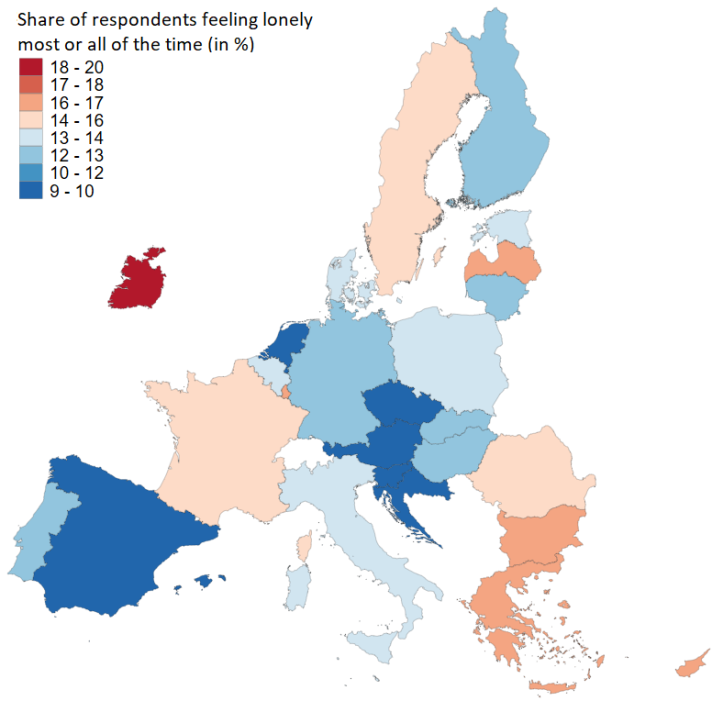The first ever EU-wide survey on loneliness, EU-LS 2022 finds that on average, 13% of respondents report feeling lonely most or all of the time over the past four weeks, while 35% report being lonely at least some of the time.
Loneliness prevalence differs across countries. This can be explained by cultural differences but also by demographic differences and, possibly, sampling differences. According to EU-LS 2022 loneliness is most prevalent in Ireland with over 20% of respondents reporting feeling lonely. Luxemburg, Bulgaria and Greece follow. The lowest levels are observed in the Netherlands, Czech Republic, Croatia and Austria (all below 10%). A similar geographical pattern was already observed for data collected during the pandemic.
Figure: The figure displays by country, the share of respondents who felt lonely most or all of the time over the past four weeks preceding the survey.
Consult the JRC publications to know more on loneliness prevalence in Europe and the associated risk factors
[2023] Policy Brief
- A new EU-wide survey yields insights into how feelings of loneliness are related to the size and quality of social relationships, to major life events and to other important factors.
- In 2022, more than one third of respondents were lonely at least sometimes and 13% were lonely most of the time.
- The prevalence of loneliness decreases with increased age, income, and education.
- Having several meaningful relationships is associated with lower loneliness levels, but the frequency of contact also matters.
- People experiencing major life events such as separation, job loss or finishing their studies are more often lonely.
[2018] Policy brief
- More than 75 million European adults meet with family or friends at most once a month and around 30 million European adults frequently feel lonely.
- Loneliness is more prevalent in Eastern and Southern Europe than in Western and Northern Europe.
- Poor health, unfavourable economic circumstances and living alone are all associated with higher rates of loneliness.
- Loneliness affects all age groups. Even though the elderly may be more socially isolated than other age groups, they do not report more frequent feelings of loneliness.
See related JRC news
[2021] Report
Research shows that loneliness and social isolation have harmful repercussions on mental and physical health, as well as significant consequences on social cohesion and community trust. Both loneliness and social isolation are hence increasingly recognized critical public health issues that deserve attention and need to be addressed with effective intervention strategies. The COVID-19 pandemic has also dramatically reshaped Europeans’ lives and social practices. Mobility restrictions and social distancing measures adopted to contain the spread of the virus prompted public discussions on the unintended side effects of such provisions. In particular, some fear that the toll of loneliness could have consequences long after the virus recedes.
This report offers an overview of the current state of knowledge on loneliness and social isolation in the EU. It presents the main findings of two empirical analyses carried out by the JRC using two complementary sources of information, namely survey and online data. The analysis based on survey data offers a picture of recent trends in self-reported levels of loneliness across the EU and identifies the prevailing socio-demographic and geographical characteristics associated with loneliness before and during the first months of the COVID-19 pandemic. Survey data show that the COVID-19 pandemic has magnified the problem. The proportion of respondents that felt lonely frequently doubled following the COVID-19 outbreak. In addition, young adults were hit more severely. The analysis based on online data looks at trends in online media reporting on loneliness and social isolation between January 2018 and January 2021.
The volume of articles on these topics is measured on a monthly basis and by Member State, and the collected articles are analysed in depth to identify the prevailing sentiments contained in them and detect patterns in the underlying narratives. Online media reporting on loneliness and social isolation has doubled during the pandemic. Narratives largely concerned the health consequences of loneliness. The analysis of online media reporting catalogues also typologies and examples of policy initiatives aimed at combating loneliness and social isolation. Public initiatives vary across Member States. Overall, most interventions are designed at local level and are rarely part of more systematic programmes.
See related JRC News
[2021] Policy Brief
On 11 March 2020, the World Health Organization first described COVID-19 as a pandemic.
Since the outbreak of the pandemic, lockdowns, quarantines, curfews, distancing measures and the cancellation of community activities and events have been implemented across Europe. While these measures were needed to control the spread of the virus, they have also led to forms of social isolation never experienced by present generations. The long-term effects on mental health are still unclear. However, experts have already warned that the toll of loneliness could have consequences long after the virus recedes.
Against this background, loneliness is increasingly recognised as an issue of public importance, with significant ramifications for social, economic and healthcare policies. This policy brief compares the incidence of loneliness in 2016 and during the first months of the COVID-19 pandemic.
The purpose is to identify the socio-demographic characteristics frequently linked with loneliness, and examine whether the risks factors associated with loneliness changed after the outbreak of the pandemic. Therefore, this analysis contributes to assess the potential consequences for the population of extended periods of forced social isolation. The ultimate goal is to support the design of targeted and effective intervention strategies.
[2022] Literature Review
The report provides a narrative review of the literature on the risk factors for loneliness.

